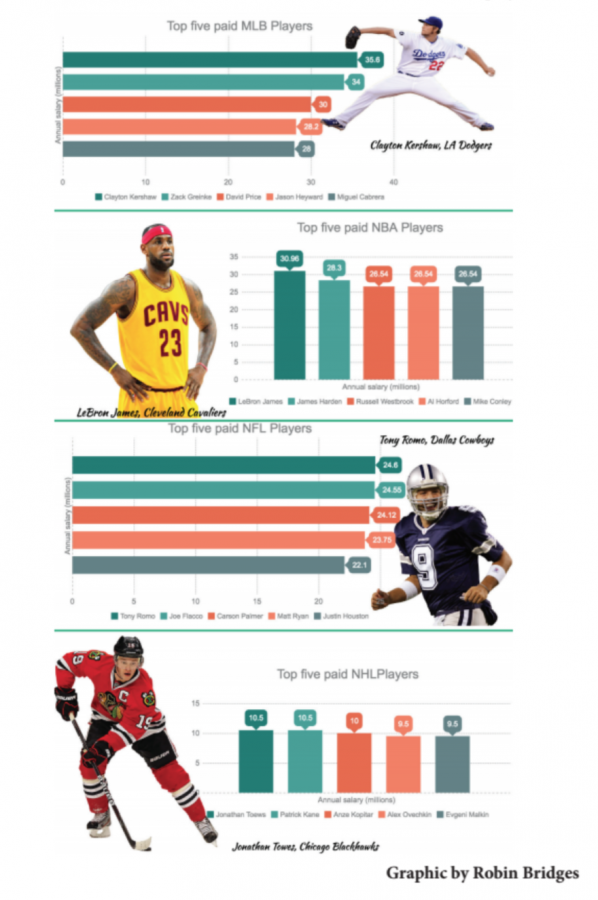Are athletes getting paid far too much?
A graph of the top five paid athletes in their respected sports.
February 21, 2017
Whether or not professional athletes are overpaid has been a long-standing debate. And in a world where some professional athletes are paid almost 100 times the salary of the average U.S. teacher, it comes as no surprise.
Regardless of whether or not you think athletes are overpaid, the issue at hand is not how much they’re being paid, but why they’re being paid that way.
In a February 2015 article for Business Insider, Cork Gaines offered up a salary comparison for the top 100 players in the four major U.S. leagues. It is no surprise that the MLB has the highest average salary amongst its top players – roughly $16.4 million per year – considering it is the only league without a salary cap. The NBA comes in second, with an $11.9 million average. The typical actual salary, not including major signing bonuses, for the NFL’s top players were little over half that of the MLB at about $9 million. Finally, rounding off the list is the NHL at about $7 million.
Obviously, not all professional athletes make that much money, but even most rookies make more money than some of the world’s other leading professionals.
So why are professional athletes making more money than most of us could ever dream of?
Well, there are many factors that go into it, such as the amount of time athletes put into perfecting their skills, the wear and tear on their bodies, and their short career spans.
As fans, we encourage and allow for athletes to get paid higher and higher salaries each year, because we keep coming back for more.
According to Steven Kutz in a July 2016 article from Market Watch, the NFL generates roughly $13 billion in revenue each year. The MLB, NBA and NHL generated $9.5 billion, $4.8 billion, and $3.7 billion respectively in 2016.
Though a good portion of this money comes from TV deals signed with major networks, a lot of it also comes from ticket sales and merchandise. As a fan of Chicago sports, I can tell you that I have purchased insanely priced tickets to Cubs and Blackhawks games, averaging around $30-$60, with no regrets. I definitely have at least one form of apparel for the Cubs, Hawks, Bulls, Bears, and yes, even the Sox. As much as I would like to sit here and say that athletes are overpaid, considering even some rookies make more than the President of the United States, I am partly responsible for funding their paychecks.
The big four are all multi-billion dollar companies, and you have to think of them in terms of a company. A successful business is only going to pay their employees what they feel they are worth.
Then you have the middle of the road employees who make above the country’s average wages. Finally, there are the department executives. These are players like Tom Brady, LeBron James and Patrick Kane, who are not only faces of the business, but also top earners for it.
My question though is where does that leave the upper management and CEO of the company?
What most people fail to realize is that professional coaches and league commissioners are making just as much, if not more, than some of these players. Now in an industry like the NFL or MLB that comes as no shock because again, these are multi-billion dollar businesses; but what about college sports?
The highest paid public employee are college coaches in 39 out of the 50 states. The highest paid public employee in the United States is Alabama’s head football coach, Nick Saban. With a winning record and a football team that is the pride of Alabama, Saban rakes in a cool $7.09 million per year. To put that into perspective, most governors of states only average $137,415, and according to the Associated Press, Alabama’s own governor, although not required to, doesn’t collect a salary.
When you take a look at the expenses of a college football team, like Alabama, compared to revenue gained, it is easy to see why Saban is paid so much.
Alicia Jessup, a contributor for Forbes, showed this comparison in an August 2013 article. Alabama spent $36.9 million that year, but brought in $82 million. Alabama was only topped by the University of Michigan and the University of Texas who spent less ($23.6 million and $25.9million respectively )and brought in more ($85.2 million and $103.8 million). Both of these team’s coaches are their state’s highest paid public employees as well.
Not all of this money comes from the government though. In a September 2016 article from 24/7 WallSt., Evan Comen said:, “The revenue stream from highly lucrative TV and other media deals and the fact that college athletes are not paid largely explain the exorbitant salaries for coaches.”
I’m guilty of watching college football every Saturday during the season, and I own gear from at least three different colleges, so again, I, as well as other fans, are still a part of the reason these coaches get paid so much.
Professional athletes and coaches have been paid lucrative salaries for years. Of course it seems crazy that a player or a coach would make more money than a doctor, lawyer, fireman, police officer, teacher, or even our president. But as fans and consumers, we keep putting the money in their pockets. We keep returning to our favorite spot on the couch, with our good friends and our usual game-day snacks every week just to watch Tom Brady throw that touchdown, LeBron James hit that three-pointer, Anthony Rizzo hit that home run , and Patrick Kane to score that goal.
Until we as fans decide to give up on our teams, they will continue to help these players make this type of money.
But as long as they keep playing, I’ll keep paying.
Enjoy this article? Check out some other NEIU Independent exclusives:
Does LeBron’s legacy compare to Jordan’s?
Eight Criminally Underrated Bands You Need to Hear
Arguments for and against equal pay for the USWNT









Owls of pp • May 13, 2021 at 8:49 am
They should use all the extra money on food banks or something
poop • Apr 19, 2021 at 11:50 am
lol
big baller • Apr 8, 2021 at 1:38 pm
School
yeetchicken • Apr 6, 2021 at 9:55 am
You guys need to learn how to spell.
no • Mar 16, 2021 at 9:02 pm
all sport organization people are going to have a huge problem in the future if they keep paying their players like this. They are losing a lot of money to supply their players with millions, so they have to put higher prices on Merch and Snacks. soon the price will get so high many people will stop buying them and lose more money. Some people will always pay the prices no matter what the cost, but a majority will probably stop buying items and the organization will just lose more money.. Im for lower salaries.
jaeden • Feb 25, 2021 at 3:53 pm
whyyyyyyyyyyyyyyyyyyyyyyyyyyyyyyyyyyyyyyyyyyyyyy
drewdabest4265 • Feb 23, 2021 at 12:21 pm
yall all are wierd
IDK • Feb 11, 2021 at 12:37 pm
Also you think anyone can actually throw a ball? You have to be really talented to even make it to college! These guys put in so much effort, I’d like to see you surrounded by guys wanting to ram you to the ground and make a 50 yard bomb. Anyway could be amazing at football and make millions, so get off you lazy asses. Also you want doctor’s and teacher’s to be paid more? Give them more money Do shit instead of complaining on the internet.
IDK • Feb 11, 2021 at 12:32 pm
Bruh people, if you don’t want athletes to earn so much, don’t watch em. In these industries the top employee’s are paid the most. This is just as petty saying oh why does the founder of amazon have so much money. Just don’t buy their service, products, or entertainment.
ehhhh • Feb 8, 2021 at 8:43 pm
technically, they need the money, they deserve it, and it’s not their fault they make that much money. They chose to have that career, so it will be given to them (at least sometimes)
icey • Jan 14, 2021 at 9:44 am
IM DOING THIS FOR SCHOOL TO AND THEESE PROFESSINIAL ATHLETES GET PAID THIS MUCH NO FAIR!! WE SHOULD WOOP THEIR *** WITH A SHOOL BUS LOL
SUSHI • Jan 12, 2021 at 2:29 pm
SAME!
Brynn • Jan 11, 2021 at 8:19 am
I am doing this for school
Fiza • Mar 4, 2020 at 6:52 pm
THEY STILL GET TO MUCH MONEYYYY THAN DOC’S NOTTTTTTTTTTTTTTTTTTT FAIRRRRRRRRRRRRRRR!!!!!!!!!!!!!!!!!!!!!!!!!!!!!!!!!!!!!!!!!!!!!!!!!!!!!!!!!!!!!!!!!!!!!!!!!!!!!!!!!!!!!!!!!!!!!!!!!!!!!!!!!!!!!!!!!!!!!!!!!!!!!!!!!!!!!!!!!!!!!!!!!!!!!!!!!!!!!!!!!!!!!!!!!!!!!!!!!!!!!!!!!!!!!!!!!!!!!!!!!!!!!!!!!!!!!!!!!!!!!!!!!!!!!!!!!!!!!!!!!!!!!!!!!!!!!!!!!!!!!!!!!!!!!!!!!!!!!!!!!!!!!!!!!!!!!!!!!!!!!!!!!!!!!!!!!!!!!!!!!!!!!!!!!!!!!!!!!!!!!!!!!!!!!!!!!!!!!!!!!!!!!!!!!!!!!!!!!!!!!!!!!!!!!!!!!!!!!!!!!!!!!!!!!!!!!!!!!!!!!!!!!!!!!!!!!!!!!!!!!!!!!!!!!!!!!!!!!!!!!!!!!!!!!!!!!!!!!!!!!!!!!!!!!!!!!!!!!!!!!!!!!!!!!!!!!!!!!!!!!!!!!!!!!!!!!!!!!!!!!!!!!!!!!!!!!!!!!!!!!!!!!!!!!!!!!!!!!!!!!!!!!!!!!!!!!!!!!!!!!!!!!!!!!!!!!!!!!!!!!!!!!!!!!!!!!!!!!!!!!!!!!!!!!!!!!!!!!!!!!!!!!!!!!!!!!!!!!!!!!!!!!!!!!!!!!!!!!!!!!!!!!!!!!!!!!!!!!!!!!!!!!!!!!!!!!!!!!!!!!!!!!!!!!!!!!!!!!!!!!!!!!!!!!!!!!!!!!!!!!!!!!!!!!!!!!!!!!!!!!!!!!!!!!!!!!!!!!!!!!!!!!!!!!!!!!!!!!!!!!!!!!!!
nofk • Mar 3, 2020 at 1:26 pm
anyone can throw and catch a ball these stupid people are getting payed millions just too throw and catch a ball
Tes Tickle • Jan 30, 2020 at 9:59 am
i think they are overpaid
fried chicken • Jan 23, 2020 at 4:04 pm
Hi there I think chickens should have sports too
Ja morant • Dec 17, 2019 at 9:01 am
All you guys can eat cock I’m an college athlete getting drafted to the NBA and will be picked #24 it’s predicted. I hope this article gets taken down and all you guys can suck my cock. 😉
HamzAleeMoha • Dec 15, 2019 at 5:00 am
Professional athletes are making too much money in a society where salaries and wages are traditionally based on the value of one’s work. In today’s society, one should be paid according to the job’s economic importance and their value to society. Teaching is one of the most economically important occupations because our future economy relies on the education of its youth, yet teachers are paid astronomically less than the average professional athlete is.
STUPID ATHLETES. GO GET YO SELF A REAL JOB!!!
Upstander • Dec 9, 2019 at 10:26 am
This Is so unfair. The soldiers dying for us should get paid more than the college sports players who yes have skill, but have no effect on today’s life. We would not be in America without soldiers who died for us.
kkole • Nov 5, 2019 at 1:38 pm
it is crazy like just shut up u pepole
aidenmckinlayaayayyy • Nov 5, 2019 at 12:38 pm
russle wislon is a better qb than tom brady change my mind
aodeindnash • Nov 5, 2019 at 12:33 pm
yeet pretty good eh
heckimryon • Aug 16, 2019 at 10:17 pm
dude this article is so correct why do athletes get paid so much is way to bad we’re kinda poor with athletes athletes commit highway robbery why do we let them do this this is one sentence (i can do better) because IM GOING CRAY – CRAY!!!!!!!!!!!!!!!!!!!!!!!!
chickenBoio • May 13, 2019 at 11:54 am
today we are gathered here to mourn the loss of Tom Brady. SIKE in all honesty f*** Tom Brady. Im glad we are gathered here for his funeral yall. he was a hoe that went to the club listening to thotiana sooo..
Chicken • May 1, 2019 at 1:45 pm
I think there should be sports games for chicken, and other animals too.
alex • Apr 25, 2019 at 2:02 pm
We should just go to communism!!!! this is crazy and un-fair! I’m a true libtard and because I don’t get my way (when the world obviously revolves around me) I think I should get money for free!
Jeff • Apr 2, 2019 at 12:17 pm
Yes these people get paid way to much
jack • Mar 18, 2019 at 2:57 pm
they should get paid alot here…. i made an article
Do Professional Sports Players Get Overpaid?
How would you like to get paid $285 million/year? I would love that. That is Floyd Mayweather makes and Lionel Messi makes $111 million/year. The real question is do professional sports players get overpaid?
Athletes are overpaid because of fans. Teams make their money through ticket sales, viewership, and merchandise sales and then pass along these earnings to their players. So, if people agree that athletes are overpaid, then they should stop creating such a high demand for sports.
The reason sports players get paid that much is because they are good and if your good fans are going to want your jersey. Take Christian Yelich for example. His salary in 2018 before he won MVP was $7 million dollars. Now in 2019 after he won MVP his salary is roughly $9 million dollars. It went up because his jersey sales, merchandise sales went up, and more people are going to want to go to his games or watch him on TV so the ratings will go up and ticket sales will go up, If you think of it, they don’t get too much money compared to what the team makes or the TV channel makes.
Athletes are role models. For example, how many police officers, doctors and schoolteachers are able to start their own charity fund? Yes, they make mistakes sometimes, but having fame like that the mistakes they make are highly publicized. Are there any better examples of hard work paying off?
big o • Mar 12, 2019 at 11:22 am
this is biff o here again with thotiana
big o • Mar 12, 2019 at 11:18 am
buss down thotiona u gone take this d***
azura • Mar 3, 2019 at 9:22 pm
joseph. these athletes win a yearly salary that can feed the poor for a whole year. your saying that these athletes get hurt and um… police and firefighters, and military officers sometimes die and don’t get paid half as much. athletes have nose bleeds for your entertainment and still get millions. other people lose their limbs, arms, and sometimes lives for your safety and for this nation and apparently athletes still diverse to get paid 2x more. think about that before you but a dumb comment like that. thank you
Big Boy Johnson • Feb 11, 2019 at 12:04 pm
LeBron is better than michael jordan…. change my mind
suki macocka • Jan 10, 2019 at 10:05 am
F**K THESE B*****S WHO GET PAID LIKE SHH****TT
|T
T}T
joseph • Nov 30, 2018 at 1:52 pm
first of all they should get more money then every one because if they get hurt they can pay it off.And your just mad that they make more money then you.Some man/woman on the web talking bad about “some rookie”.
logan • Oct 5, 2018 at 8:30 am
i think they deserve the money
shawn warner • Aug 29, 2018 at 11:50 am
tom brady is only the 12th highest paid quarterback of the NFL right now. back in 2017 when you wrote this article, he was only the 20th highest paid quarterback. no where near the “top earner” of the NFL as you stated.
shawn warner • Aug 29, 2018 at 11:47 am
you are aware Tom Brady’s only the 12th highest paid quarterback in the NFL right now. back in 2017 when you wrote this, he was the 20th highest paid quarterback. no where near the top earner of the NFL
Abdullah Hassan • Feb 21, 2018 at 11:42 am
Literally, they don’t need this much money. Why do they get this much money? I mean, some rookies even get paid more than the president! THIS IS MAD PAYING!!!!!!!!!!!!!!!!!! Teachers, Police and Fire Officers should get paid that much, not some random rookie!
Itz_Gannon12 • Mar 16, 2018 at 12:04 pm
Bro Abdullah its firemen not fire officers.
Laylaoncomputer • Dec 19, 2017 at 1:56 pm
yyep thats true…..
SO BOO HOOOOOOOO SPORTS PPL
LILY • Dec 19, 2017 at 1:54 pm
i would like to challange the sports team .why are they allowed to get paid an insane amount of money for being a VERY VERY VERY bad example on the pitch. SO BOO HOO
LILY • Dec 19, 2017 at 1:55 pm
NICE MEH
LILY • Dec 19, 2017 at 1:52 pm
WHYYYYYYYYYYYYYYYYYYYYYYYYYYYYYYYYYYYYYYYYYYYYYYYYYYYYYYYYYYYYYYYYYYYYY DO THEY NEED SO MUCH MONEY PPL